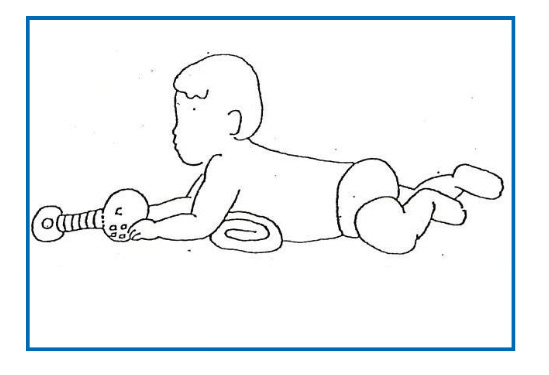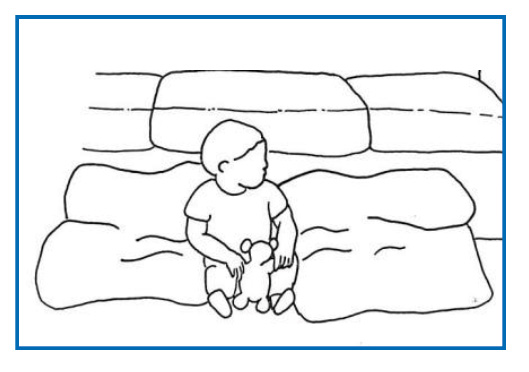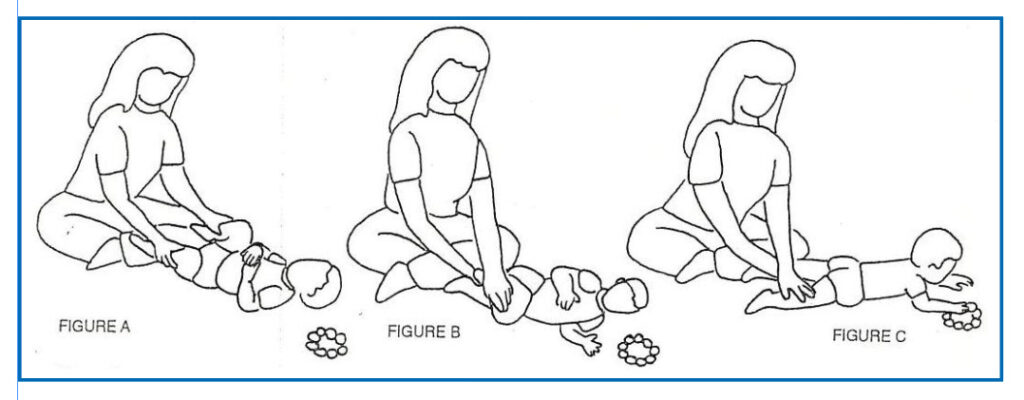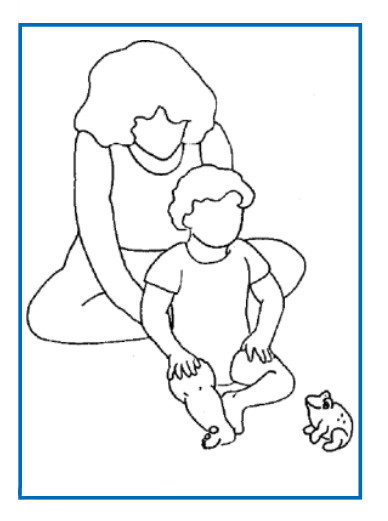On this page
Does your child have a Congenital Heart Condition?
Play and Activities for babies and Children 0-12 months
Babies and Children with congenital heart conditions need to be involved in play as much as possible. Regular position changes will help them develop their motor skills.
Babies with congenital heart conditions may develop at different speeds but we would anticipate that they still follow the normal milestones. They need opportunity to explore their environment.
If your child has had a sternotomy (surgery involving an incision down the middle of the chest) then it may be necessary to avoid tummy time for six weeks following surgery and scoop them to pick them up. However after six weeks tummy time should be encouraged.
If your baby has had a thoracotomy (surgery involving an incision round the side of the chest) or has not had surgery at all they can start tummy time from new born.
Most babies and children will not require any extra help or advice to enable them to develop, occasionally if they are not progressing as well as anticipated they maybe referred for physiotherapy.
If you are worried about their development please discuss with your Cardiologist, Paediatrician, Specialist Nurse or Physiotherapist.
The Children’s Physiotherapy team at Leeds Children’s Hospital can offer advice on 0113 392 0609
0-3 months developmental activities
Please ensure that your back is well supported when carrying out all activities.
Child on their back

Encourage:
- Head in line with the body
- Arms forward and down, hands together
- Hips bent and legs relaxed
Helps to:
- Develop eye contact with you
- Enable hands to reach and touch legs
- Develops stomach muscles
- Reduces arching
Play ideas:
- Small lightweight toys in midline to explore
- Watching toys move side to side
- Eye contact and interaction, singing songs together
Child on your tummy

Encourage:
- Arms forward
- Head in midline
- Weight bearing on forearms
- Little and often
Helps to:
- Develop eye contact with you
- Develop back muscles
- Develop head control
- Strengthen arms and shoulders
Play ideas:
- Eye contact with you
- Interacting and singing with baby
- ‘Cooing’ at baby
Child in side lying

Encourage:
- Shoulders forward and hands together
- Bend top leg to help balance
- Place bottom leg straighter
Helps to:
- Bring arms and legs together
- Develop play skills in midline
- Develop the beginnings of rolling.
- Develop the rib cage muscles and enhances breathing capacity
Play ideas:
- Toys in both hands
- Small lightweight rattles
- Mirror
3-6 months developmental activities
Please ensure that your back is well supported when carrying out all activities.
Child supported between your legs

Encourage:
- Child supported between your legs or lying on the floor
- Encourage child to reach for feet
- You may have to help them with this
Helps to:
- Promote awareness of the hands and feet
- Develop head control
- Aid awareness of feet and of midline
Play ideas:
- Small lightweight toys placed on feet (foot rattles)
- Tickle feet
- Sensory toys and different textures on feet
Child on tummy with roll under chest

Encourage:
- Head up in line with the body
- Arms out from under the body and in front of the towel
- Elbows under or slightly in front of the shoulders
Helps to:
- Develop head control
- Develop muscles in the arms and shoulders
- Develops muscles of the back
Child propped up with pillows in sitting

Encourage:
- Head upright in line with body
- Body upright and straight
- Hips at 90 degrees and legs forward
- Arms forward and down
Helps to:
- Develop balance
- Develop muscles of the body, back and hips
- Free the arms for play
- Develop independence in sitting
Play ideas:
- Sit in front of child and encourage play with toys
- Knocking over stacking blocks
- Singing songs
Facilitating child to roll

Encourage:
- Head in line with body
- Body straight, then rolling to follow the movement of the hips
- Arms down, out from under the body
- Top hip bent when rolling, both hips flat when on tummy
Helps to:
- Develop muscles of the tummy and back
- Develop body coordination for rolling
- Allow the child to experience shifting of body weight
Play ideas:
- Place a musical toy or brightly coloured toy next to the childís shoulder but just out of reach to entice them
- Sing a song and complete roll in time to the music
6-9 months developmental activities
Please ensure that your back is well supported when carrying out all activities.
Child supported in sitting

Encourage:
- Child to reach for toys in front of them and then side to side
Helps to:
- Develop hand eye coordination
- Develop balance
- Develop advanced sitting skills
- Expose child to shift of body weight and how to maintain balance
Play ideas:
- Row row row your boat rhyme
- Rolling a ball between child and parent/carer
- Place a toy just out of reach.
Child learning move through different positions

Encourage:
- Head and body upright when side sitting
- Body over leg when on hands and knees
Helps to:
- Develop muscles of the body, hip, shoulders and arms
- Develop coordination
- Allow child to experience shifting of weight
- Pre-cursor to crawling
Play ideas:
- Put toy the other side of your leg to encourage child over your leg onto hands and knees
Child in crawling position

Encourage:
- Head in line with body
- Shoulders even, arms straight elbows under shoulders
- Hands under elbows, hands open
- Knees under hips
Helps to:
- Develop muscles in the upper and lower limbs
- Develop balance
- Develop muscles for crawling
Play ideas:
- Gently use your hands to rock child backwards and forwards
- Sing a song
- Help the child push a ball or reach for a toy
Child reaching for toys whilst on tummy

Encourage:
- Child starting to control own body and needing less support
- Reaching further for toys and up in the air
- Do little and often.
Helps to:
- Develop balance
- Increase weight bearing through upper limb
- Encourage transition from sitting to crawling.
Play ideas:
- Place toy out of reach in front and to one side to encourage child into side sit
Child learning to move from tummy to sitting

Encourage:
- Child to come up into a sitting position
- Weight bearing on arm
- Trunk rotation
Instructions:
- Place child lying on stomach. One of your hands should be on the opposite hip, place your other hand under arm next to you
- Gently pull up back and then down on hip, assist as needed under the shoulder by pulling forward and up
- This activity should be done slowly and steadily to encourage child to help in coming to a sitting position
9-12 months developmental activities
Please ensure that your back is well supported when carrying out all activities.
Child crawling across your lap

Encourage:
- Head in line with body
- Arms straight and elbows and hands underneath shoulders, hands flat on the floor
- Knees under hips
Helps to:
- Develop balance
- Develop muscles of back
- Develops muscles in upper limbs
Play ideas:
- Place a puppet on your hand or a favourite toy on the other side of your leg to encourage child to crawl over your leg
Child supported to cruise/ Side step along furniture

Encourage:
- Head upright in line with chin, body upright and straight
- Feet flat on the floor facing forward
- Arms on forward on the stool to play or lean on
Helps to:
- Develop muscles of the body
- Develop balance and control of body
- Increase weight bearing through lower limbs
Play ideas:
- Child can pretend to be a drummer with rattles or wooden spoon on the stool
- Push cars along the top of the stool
- Place a book on the stool for child to look at.
Child learning to move from kneel, to half kneel, to stand

Encourage:
- Head and body upright and straight
- Knees start off bent then one becomes flexed as the child come up into half kneeling then support given to come up into standing.
Helps to:
- Develop muscles of the legs, hips and body
- Develop ability to shift body weight forward and up over the feet
- Develop coordination of the legs
- Develop balance
Play ideas:
- Place toy or snack on the table to encourage child to come up into standing.
Child learning to push a walker

Encourage:
- Child to pull up to the walker
- Walk on carpet rather than laminate to begin with
- Walk in straight lines free from obstacles
Helps to:
- Develop balance
- Develop muscles for walking
- Increase confidence to take independent steps
Play ideas:
- Walkers
- Trolley with blocks
- Push a baby or a teddy
Child learning to reach away from support

Encourage:
- Turning head to look for and reach toy behind them
- Reaching between two pieces of furniture
- Gradually increase the distance between furniture to encourage stepping.
Helps to:
- Refine development of balance control of the body and legs
- Develop coordination
- Gain confidence in standing in preparation for walking
Play ideas:
- Place toys or snack on a table or stool behind the child to encourage them to turn round and reach.
- Place blocks on one surface and encourage child to move them from one surface to another.
Please discuss your child’s activity with your local Cardiologist and Paediatrician.
They will be able to refer you to your local Physiotherapy service for further guidance if required.
Information published by Specialist Children’s Physiotherapists, Leeds Children’s Hospital and the Yorkshire & Humber Congenital Heart Disease Network.